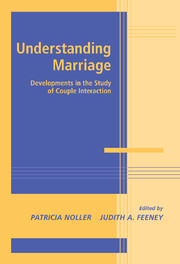Book contents
- Frontmatter
- Contents
- Contribitors
- Introduction
- SECTION ONE THE EFFECT OF COGNITION ON INTERACTION PATTERNS
- SECTION TWO UNDERSTANDING THE IMPORTANCE OF POSITIVE INTERACTION
- Introduction to Section Two
- 5 Observational “Windows” to Intimacy Processes in Marriage
- 6 Bases for Giving Benefits in Marriage: What Is Ideal? What Is Realistic? What Really Happens?
- 7 Shared Participation in Self-Expanding Activities: Positive Effects on Experienced Marital Quality
- SECTION THREE COPING WITH DISAPPOINTMENT, CRITICISM, AND BETRAYAL
- SECTION FOUR POWER, CONFLICT, AND VIOLENCE IN MARITAL INTERACTION
- Marital interaction at important transition periods
- SECTION SIX Interventions for strengthening relationships
- Conclusions
- Index
Introduction to Section Two
Published online by Cambridge University Press: 25 July 2009
- Frontmatter
- Contents
- Contribitors
- Introduction
- SECTION ONE THE EFFECT OF COGNITION ON INTERACTION PATTERNS
- SECTION TWO UNDERSTANDING THE IMPORTANCE OF POSITIVE INTERACTION
- Introduction to Section Two
- 5 Observational “Windows” to Intimacy Processes in Marriage
- 6 Bases for Giving Benefits in Marriage: What Is Ideal? What Is Realistic? What Really Happens?
- 7 Shared Participation in Self-Expanding Activities: Positive Effects on Experienced Marital Quality
- SECTION THREE COPING WITH DISAPPOINTMENT, CRITICISM, AND BETRAYAL
- SECTION FOUR POWER, CONFLICT, AND VIOLENCE IN MARITAL INTERACTION
- Marital interaction at important transition periods
- SECTION SIX Interventions for strengthening relationships
- Conclusions
- Index
Summary
Although marital interaction has been extensively studied, much of the research has focused on conflict processes and their implications for relationship functioning. This focus was often adopted because negative processes were believed to be particularly powerful discriminators between satisfied and dissatisfied couples. More recently, however, researchers have begun to recognize the importance of positive interaction processes in maintaining relationship satisfaction.
As Roberts and Greenberg point out, the period leading up to the decision to marry is typically one of great joy, intimacy, and positivity. They contrast two radically different perspectives on the development of marital dysfunction. On the one hand, the negative affect model emphasizes the destructive role of conflict and negativity in marital breakdown. On the other hand, the intimacy process model, while recognizing the importance of responses to conflict, focuses on the role of positive interactions in maintaining relationship satisfaction. According to this latter perspective, positive exchanges serve to maintain a climate of trust, respect, and acceptance; in the absence of such a climate, relationship stress and conflict are likely to escalate.
As these authors note, there are many approaches to the observational assessment of conflict interaction. Although positive behavior can be observed in these interactions, discussion of conflict topics is unlikely to provide prototypical examples of positive couple behavior. New approaches, which are more likely to elicit positive interaction, need to be developed.
- Type
- Chapter
- Information
- Understanding MarriageDevelopments in the Study of Couple Interaction, pp. 115 - 117Publisher: Cambridge University PressPrint publication year: 2002



